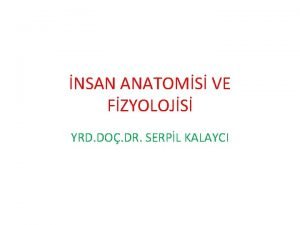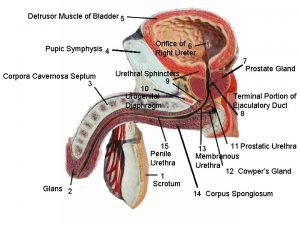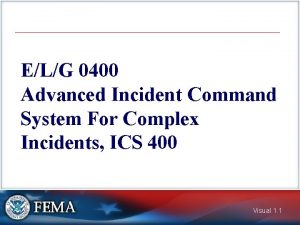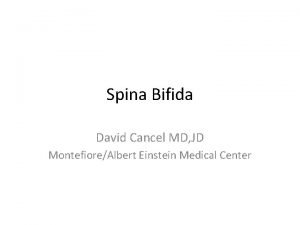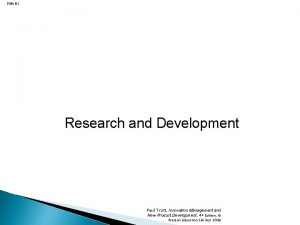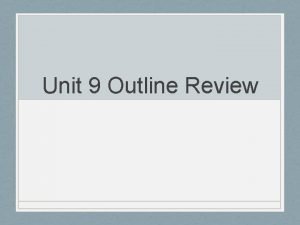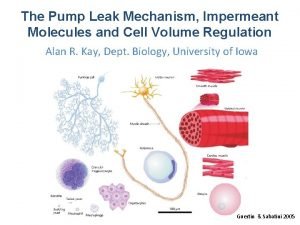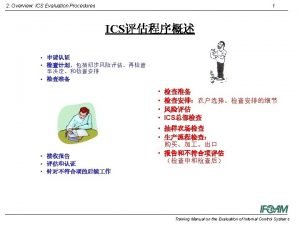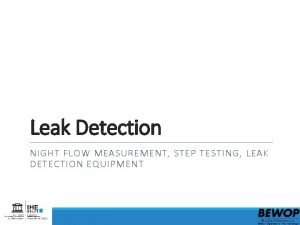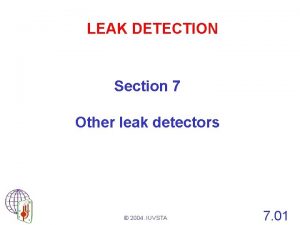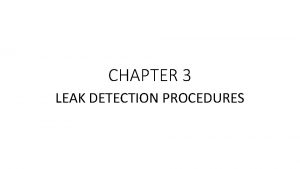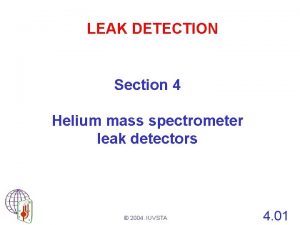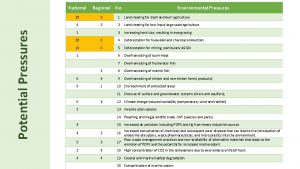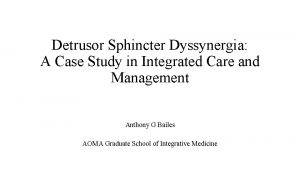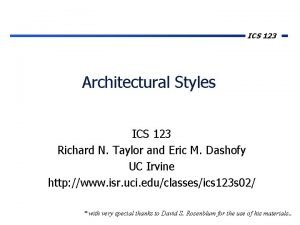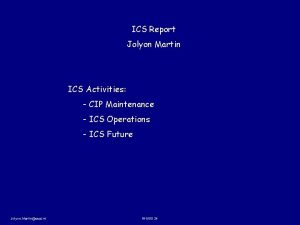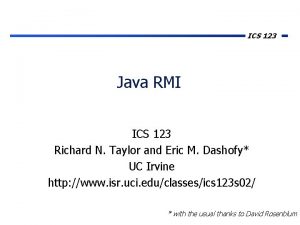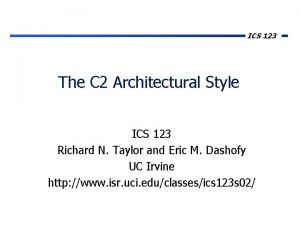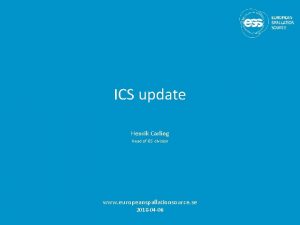ICS Teaching Module Detrusor Leak Point Pressures DLPP


























- Slides: 26

ICS Teaching Module: Detrusor Leak Point Pressures (DLPP) in Patients with Relevant Neurological Abnormalities T Tarcan, O Demirkesen, M Plata & D Castro-Diaz International Continence Society Teaching Module 1

Background • Mc. Guire, 1981 − Observations of videourodynamic studies of children with MMC and UI secondary to impaired bladder compliance − The predictors for upper urinary tract deterioration (UUTD)* • Further applied to different etiologies of neurogenic lower urinary tract dysfunction (N-LUTD) in adults *Mc. Guire EJ, Woodside JR, Borden TA. Upper urinary tract deterioration in patients with myelodysplasia and detrusor hypertonia: a followup study. J Urol 1983; 129: 823 -6. Teaching Module 2

The ICS definition of DLPP The lowest detrusor pressure at which urine leakage occurs in the absence of either a detrusor contraction or increased abdominal pressure* *Abrams P, Cardozo L, Fall M, Griffiths D, Rosier P, Ulmsten U, van Kerrebroeck P, Victor A, Wein A; Standardisation Sub-committee of the International Continence Society. The standardisation of terminology of lower urinary tract function: report from the Standardisation Sub-committee of the International Continence Society. Neurourol Urodyn. 2002; 21: 167 -78. Teaching Module 3

Controversies • The value of DLPP to predict UUTD? ? • Measuring DLPP lacks standardization and carries pitfalls • Using DLPP in N-LUTD during detrusor contractions (neurogenic detrusor overactivity) instead of reduced bladder compliance Teaching Module 4

The ICS Urodynamics Committee Teaching Module • Webcasted presentation in combination with a manuscript • A standard education of Good Urodynamic Practice for everyone, who is caring for patients with NLUTD *http: //www. icsoffice. org/e. Learning/. . . or via the QR code on this page. Teaching Module 5

Introduction • The presentation • testing requirements, clinical workup and analysis • The manuscript • scientific background review and the evidence base for the ICS Power Point presentation* • Aim • To standardize and improve the method of DLPP measurement in patients with N-LUTD to minimize performer- and patient dependent variations *http: //www. icsoffice. org/e. Learning/. . . or via the QR code on this page. Teaching Module 6

Preparation and Technique • ICS reports on Good Urodynamic Practices (GUP) and urodynamic equipment performance* • The International Children’s Continence Society (ICCS) report on the standardization of terminology of lower urinary tract function** *Schäfer W, Abrams P, Liao L, Mattiasson A, Pesce F, Spangberg A, Sterling AM, Zinner NR, van Kerrebroeck P; International Continence Society. Good urodynamic practices: uroflowmetry, filling cystometry, and pressure-flow studies. Neurourol Urodyn. 2002; 21: 261 -74. **Nevéus T, von Gontard A, Hoebeke P, Hjälmås K, Bauer S, Bower W, Jørgensen TM, Rittig S, Walle JV, Yeung CK, Djurhuus JC. The standardization of terminology of lower urinary tract function in children and adolescents: report from the Standardisation Committee of the International Children's Continence Society. J Urol. 2006; 176(1): 314 -24 Teaching Module 7

Technique I • Standard urodynamic equipment • Patients in supine position with empty bladder − ICI recommends sitting position in suitable patients (grade B)* − No evidence for the influence of specific positioning of patients with N-LUTD on the DLPP *Rosier P. F. W. M. , Kuo H-C, De Gennaro M, Kakizaki H, Hashim H, Van Meel TD, Hobson PT. Urodynamic Testing. In 5 th International Consultation on Incontinence, Paris February, 2012. Editors: Paul Abrams, Linda Cardozo, Saad Khoury, Alan Wein. 5 th EDITION 2013. Teaching Module 8

Technique II Catheter • Using progressively larger catheters increase DLPP − Small cystometry catheter (≤ 10 F) − As thin as possible, ‘one-catheter-systems’ Lo. E 4* − 5 -8 F double lumen cystometry catheters during water cystometry • Underestimation of DLPP when suprapubical catheter is used *Rosier P. F. W. M. , Kuo H-C, De Gennaro M, Kakizaki H, Hashim H, Van Meel TD, Hobson PT. Urodynamic Testing. In 5 th International Consultation on Incontinence, Paris February, 2012. Editors: Paul Abrams, Linda Cardozo, Saad Khoury, Alan Wein. 5 th EDITION 2013. Teaching Module 9

Technique III Filling rate • Not standardized in the ICS GUP • Usually done with a rate dependent on age (from 20 ml/min in children to 30 -60 ml/min in adults) − Detrusor adaptation to volume (compliance) may be challenged in high filling rates • Classified as physiologic and non-physiologic by ICS rather than slow-medium-rapid* *Abrams P, Cardozo L, Fall M, Griffiths D, Rosier P, Ulmsten U, van Kerrebroeck P, Victor A, Wein A; Standardisation Sub-committee of the International Continence Society. The standardisation of terminology of lower urinary tract function: report from the Standardisation Sub-committee of the International Continence Society. Neurourol Urodyn. 2002; 21: 167 -78. Teaching Module 10

Technique IV • Day-to-day bladder capacity by using voiding or catheterization diary-volumes • 5 -10% of known or predicted capacity may be used in children* • Slow filling rate in adult neurogenic patients with a known hypocompliant bladder (Ex. Op) *Nevéus T, von Gontard A, Hoebeke P, Hjälmås K, Bauer S, Bower W, Jørgensen TM, Rittig S, Walle JV, Yeung CK, Djurhuus JC. The standardization of terminology of lower urinary tract function in children and adolescents: report from the Standardisation Committee of the International Children's Continence Society. J Urol. 2006; 176(1): 314 -24 Teaching Module 11

Technique V • Infusion pump devices rather than gravity-type infusion systems • Avoid iatrogenic bladder pressure increases • The influence of fluid temperature on DLPP is never studied • More accurate representation of bladder activity with natural fill (ambulatory) cystometry in children Teaching Module 12

Technique VI • Detection of urinary leakage – One person observing for leakage and another observing the recording and marking pressures – More accurately fluoroscopic visualization of contrast around the catheter • Cystometry may be stopped when*; – Pdet exceeds 40 cm. H 2 O – Maximum bladder volume at intermittent catheterization is reached – A detrusor contraction occurs *Mc. Guire EJ, Cespedes RD, O'Connell HE. Leak-point pressures. Urol. Clin North Am. 1996; 23: 253 -62 Teaching Module 13

Technique VII • End filling pressure (EFP) − When the cystometry is ended without leakage • Neurogenic Detrusor Overactivity Leak Point Pressure (NDOLPP)* − If leakage occurs with an episode of neurogenic detrusor overactivity (N-DO) any time during filling cystometry • Detrusor Overactivity Leak Point Pressure (DOLPP)** − In non-neurogenic women with urgency *N-DOLPP has not been defined yet, but suggested by the authors of this module **Smith AL, Jaffe WI, Wang M, Wein AJ. Detrusor overactivity leak point pressure in women with urgency incontinence. Int Urogynecol J. 2012; 23: 443 -6. Teaching Module 14

Basic Pathophysiology • DLPP is the pressure which overwhelms the bladder outlet resistance and causes urinary leakage − Reflection of the resistance of the bladder outlet or external sphincter • DLPP > 40 cm in patients with MMC were at risk of developing UUTD − Accepted as a cutoff value without high Lo. E* • Reduction of outlet resistance for improving safe bladder storage and preserving upper tracts? *Mc. Guire EJ, Woodside JR, Borden TA. Upper urinary tract deterioration in patients with myelodysplasia and detrusor hypertonia: a followup study. J Urol 1983; 129: 823 -6. Teaching Module 15

Clinical Implications I • The absolute values of DLPP are unreliable − No UUT deterioration of several patients with DLPP's of >40 cm. H 2 O in the long term follow-up* − Higher sensitivity of 20 cm H 2 O to predict the risk group for UUT deterioration in children** *Combs AJ, Horowitz M. A new technique for assessing detrusor leak point pressure in patients with spina bifda. J Urol 1996; 156: 757 -60. **Tarcan T, Tinay İ, Sekerci ÇA, Alpay H, Şimşek F: Is 40 cm H 2 O detrusor leak point pressure (DLPP) cut-off really reliable for upper urinary tract (UUT) protection in children with myelodysplasia? Annual Meeting of the American Urological Association, April 25 -30, 2009, Chicago, IL. Teaching Module 16

Clinical implications II • The (clinical) significance of DO-LPP vs DLPP in NLUTD? • Similar risk for future UUT changes of frequent DO episodes with high LPP – Significant association with hydronephrosis in patients with N-DOA >75 mm. H 2 O* – The total duration of DO contractions** • The only statistically significant urodynamic variable for upper tract dilatation or vesicoureteral reflux in spinal cord lesion patients *Ozkan B, Demirkesen O, Durak H, Uygun N, Ismailoglu V, Cetinel B. Which factors predict upper urinary tract deterioration in overactive neurogenic bladder dysfunction? Urology. 2005 Jul; 66(1): 99 -104. **Linsenmyer TA, Bagaria SP, Gendron B et al. The impact of urodynamic parameters on the upper tracts of spinal cord injured men who void reflexly. J Spinal Cord Med 1998; 21: 15 -20 Teaching Module 17

Clinical implications III • The treatment of patients with a high DLPP • Reducing number and amplitude of overactive detrusor contractions and improving bladder compliance • DLPP may estimate how much and how long the urinary tract system will be exposed to high pressure in-between bladder emptying periods (with or without CIC) Teaching Module 18

Clinical implications IV • Significant number of patients with N-LUTD do not leak during the study • In patients with EFP or DLPP >40 cm. H 2 O* − Increased bladder wall thickness − Increased urinary levels of TGF-b 1, NGF and TIMP-2 • Alternative methods, as biomarkers? *Sekerci CA, İşbilen B, İşman F, Akbal C, Şimşek F, Tarcan T: Urinary NGF, TGF β-1, TIMP-2 and bladder wall thickness predict neurourological findings in children with myelodysplasia. J Urol 2014; 191(1): 199 -205. Teaching Module 19

Conclusions and recommendations I • DLPP − A part of cystometric evaluation of children and adults with N-LUTD to help predicting (and preventing) UUTD (Grade B/C) • Recommendations of ICS and ICCS should be followed for cystometric equipment and for the measurement technique Teaching Module 20

Conclusions and recommendations II • Discrimination of high risk (for UUTD) patients on the basis of DLPP (Grade B/C) • Not to be used as the sole parameter to decide on invasive therapies, e. g. − Bladder augmentation and sphincterotomy Teaching Module 21

Conclusions and recommendations III • Other factors to predict UUTD in N-LUTD − Bladder compliance − Volume where leakage occurs − Duration and amplitude of detrusor contractions − Volume which obtained by CIC • Low sensitivity of traditional cutoff for DLPP − >40 cm. H 2 O for the prediction of UUTD Teaching Module 22

Conclusions and recommendations IV • Future research to standardize the technique and better classify DLPP cutoffs in N-LUTD • The predictive value of LPP may differ according to underlying etiology of N-LUTD such as MMC, MS or SCI. Teaching Module 23

Conclusions and recommendations V • Cystometric readings should be sub-classified and differentiated according to presence of neurogenic DO NDO-LPP DLPP Teaching Module 24

Conclusions and recommendations VI • EFP should be taken into consideration if the leakage does not occur during cystometry however, the clinical relevance of EFP is unclear. Teaching Module 25

Thank you Teaching Module 26
 Dlpp-261
Dlpp-261 Cost pressures and pressures for local responsiveness
Cost pressures and pressures for local responsiveness Nefron
Nefron Henle kulpunda en fazla reabsorbsiyona uğrayan madde
Henle kulpunda en fazla reabsorbsiyona uğrayan madde Detrusor muscle
Detrusor muscle Detrusor apron
Detrusor apron Ics 400: advanced ics for complex incidents-aberdeen
Ics 400: advanced ics for complex incidents-aberdeen Leak point
Leak point R410a pt chart
R410a pt chart Partial pressures law
Partial pressures law Heart chamber pressures
Heart chamber pressures Chapter 18 handling social pressures
Chapter 18 handling social pressures Pronatalist pressure
Pronatalist pressure Strategic pressures on r&d
Strategic pressures on r&d William zinsser college pressures
William zinsser college pressures The maximum safe working pressure for acetylene is
The maximum safe working pressure for acetylene is Responding to economic pressures in ob
Responding to economic pressures in ob Responding to economic pressures in ob
Responding to economic pressures in ob Gibbs free energy equation units
Gibbs free energy equation units Partial pressures of gases pogil answers
Partial pressures of gases pogil answers Carburizing flame definition
Carburizing flame definition Business pressures responses support model
Business pressures responses support model C device module module 1
C device module module 1 Teaching and assessment of grammar module 1
Teaching and assessment of grammar module 1 Definition of micro teaching
Definition of micro teaching Variable leak valve vacuum
Variable leak valve vacuum Pump leak model
Pump leak model


